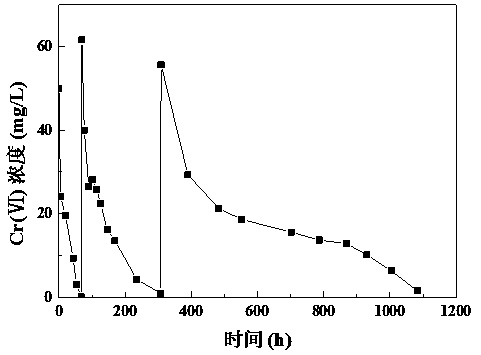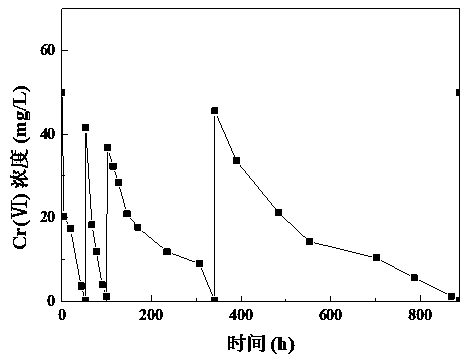Novel in-situ remediation agent MOC for Cr(VI) contaminated groundwater and preparation method of remediation agent MOC
An in-situ remediation agent and groundwater technology, which is applied in the treatment of polluted groundwater/leachate, water pollutants, biological water/sewage treatment, etc. It can solve the problem of lack of Cr(VI)-contaminated groundwater in-situ bioremediation agent. , to achieve the effect of low cost, long reagent life and wide source
- Summary
- Abstract
- Description
- Claims
- Application Information
AI Technical Summary
Problems solved by technology
Method used
Image
Examples
Embodiment 1
[0035] In this example, the potassium dichromate solution prepared in the laboratory was selected as the simulated groundwater Cr(VI) pollution, and the purchased river sand was used to simulate the aquifer medium.
[0036] Experimental system: 250g medium sand (particle size between 0.25mm-5mm) + 100ml restoration agent MOC (ascorbic acid 0.03g, sugar cane syrup 0.2g, emulsified oil 1.6g, NaHCO 3 0.15g to make 100ml solution) + 100ml 100mg / LCr(Ⅵ) (the actual Cr(Ⅵ) concentration in the system is 50mg / L after adding repair reagent).
[0037] Experimental steps: Weigh 250g of sand, add 100ml of pollution solution prepared by potassium dichromate to it, shake it well, then add repair agent MOC into the simulation device, shake it again and put it in a constant temperature incubator at 25°C for reaction . After detecting that the Cr(Ⅵ) concentration is lower than 0.5 mg / L, add potassium dichromate solution again with a solution volume of 200ml in the equilibrium system, so that t...
Embodiment 2
[0046] In this example, the potassium dichromate solution prepared in the laboratory was selected as the simulated groundwater Cr(VI) pollution, and the purchased river sand was used to simulate the aquifer medium.
[0047] Experimental system: 250g medium sand + 100ml restoration agent MOC (ascorbic acid 0.03g, sugarcane syrup 0.5g, emulsified oil 0.6g, sodium bicarbonate 0.15g to make 100ml solution) + 100ml 100mg / L Cr(Ⅵ) (after adding restoration reagent The actual Cr(Ⅵ) concentration in the system is 50mg / L).
[0048] Experimental procedure: Weigh 250g of sand, add 100ml of pollution solution prepared by potassium dichromate into it, shake it well, then add repair reagent into the simulation device, shake it again and put it in a constant temperature incubator at 25°C for reaction. After detecting that the Cr(Ⅵ) concentration is lower than 0.5mg / L, add potassium dichromate solution again with a solution volume of 200ml in the equilibrium system, so that the concentration i...
Embodiment 3
[0057] In this example, the potassium dichromate solution prepared in the laboratory was selected as the simulated groundwater Cr(VI) pollution, and the purchased river sand was used to simulate the aquifer medium.
[0058] Experimental system: 250g medium sand + 100ml restoration agent MOC (ascorbic acid 0.03g, sugarcane syrup 0.2g, emulsified oil 1.6g, sodium bicarbonate 0.15g to make 100ml solution) + 100ml 50mg / L Cr(Ⅵ) (after adding restoration reagent The actual Cr(Ⅵ) concentration in the system is 25mg / L).
[0059] Experimental procedure: Weigh 250g of sand, add 100ml of pollution solution prepared by potassium dichromate into it, shake it well, then add repair reagent into the simulation device, shake it again and put it in a constant temperature incubator at 25°C for reaction. After detecting that the Cr(Ⅵ) concentration is lower than 0.5mg / L, add potassium dichromate solution again with a solution volume of 200ml in the equilibrium system, so that the concentration is...
PUM
| Property | Measurement | Unit |
|---|---|---|
| Particle size | aaaaa | aaaaa |
Abstract
Description
Claims
Application Information
 Login to View More
Login to View More - R&D
- Intellectual Property
- Life Sciences
- Materials
- Tech Scout
- Unparalleled Data Quality
- Higher Quality Content
- 60% Fewer Hallucinations
Browse by: Latest US Patents, China's latest patents, Technical Efficacy Thesaurus, Application Domain, Technology Topic, Popular Technical Reports.
© 2025 PatSnap. All rights reserved.Legal|Privacy policy|Modern Slavery Act Transparency Statement|Sitemap|About US| Contact US: help@patsnap.com



